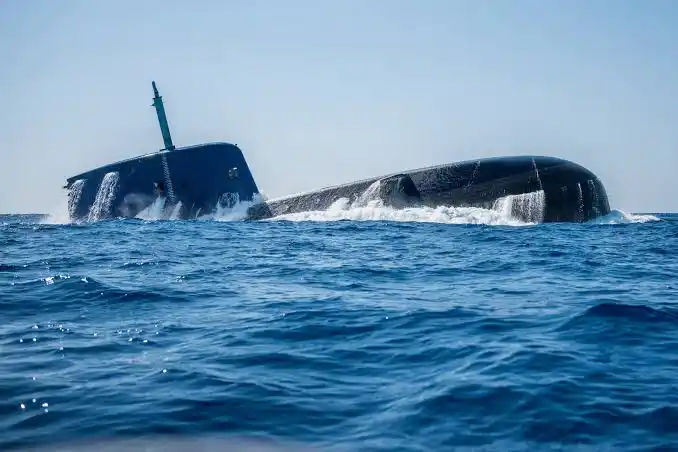In the history of naval operations, sideliners have been regaled with stories of intriguing naval battles between great powers. However, unlike their surface cousins, stories of submarine exploits are usually kept in the dark consistent with their “silent” nature.
This has reinforced the mystery usually surrounding submarine operations by those not in the naval branch. Nevertheless, few times we’re opportune to glimpse into some past daring or heroic acts of this silent underwater vessels.
One of such occasion was reported to have occurred on September 30, 2021 between Algerian naval anti-submarine forces, and an Israeli submarine around the Algerian coast.
On the hunt for a Dolphin
Off the coast of Algeria, an Israeli Dolphin-class submarine tried to track a training launch of a cruise missile Club-S from a submarine of project 636, but in turn, it was discovered and pursued by two submarines of Project 636. They forced it to surface and leave the area.
The Algerian National Navy detected an Israeli Dolphin submarine on the edge of Algerian international waters, chased it and forced it to rise to the surface before leaving the area.
The training exercise, which saw the participation of many Algerian naval units, was intended to demonstrate the capabilities of in-depth attack or stealth destruction of targets at sea at very long distances, during the drill, an Israeli Dolphin class submarine was spotted by passive detection.
Dolphin cornered by Lynx
The decision was quickly taken to pursue it aggressively without the use of sonar in order to avoid counter detection. Two Super Lynx anti-submarine warfare helicopters were launched from BDSL Kalaat Beni Abbas, which was part of the training as a command ship. The two helicopters continued the pursuit while two Kilo submarines pushed the intruder back to the north.
The two Super Lynx anti-submarine warfare helicopters tracked the Israeli Dolphin-class submarine, after which it was cornered by two Algerian navy project 636 submarines, and then forced to surface in international waters and leave the area.
After having being surrounded, the Dolphin surfaced to indicate that it was abandoning the mission and moved away from the Algerian coast. It surfaced 5 km north of Kalaat Ben Abbès, on the edge of international waters outside the training zone.
Cloak and Daggers
Apparently, it was gathered that the Israeli submarine was carrying out covert intelligence mission in order to gather information about the land-attack capabilities of Algerian Project 636 submarines which had earlier fired Kalibr Club-S submarine-launched cruise missiles. The same the missiles used by the Russian army in Syria.
During the exercise, the Algerian Project 636 submarines had launched multiple Kalibr Club-S submarine-launched cruise missiles against land targets which successfully hit their marks.
The Israeli Dolphin submarine intended to obtain critical acoustic signature indicating the opening of the missile racks and would have recorded the sound of the firing preparation and firing routine.
Such valuable information that could help predict the actions taken by Algerian crews in the event of a conflict. The mission was also an opportunity to make electronic intelligence and collect data on the transmissions of the Algerian Navy and their encryption.
Israeli submarine fleet
Based at Haifa, the Israeli Navy (IN) currently operates five modern diesel-electric Dolphin-class submarines. All were designed and constructed by Germany’s Howaldtswerke-Deutsche Werft (HDW). Israel currently possesses five Dolphin-class diesel-electric submarines. Three of the five are old Dolphin type vessels.
The older Dolphin-class are 57.3 meters long with a 6.8-meter-wide beam and can travel up to 20 knots when submerged. They can remain submerged for 30 days without surfacing. Their weapons systems are capable of firing torpedoes.
The modernized Dolphin II-class vessels instead run on a conventional diesel led-acid battery system. They have an AIP system which allows the vessels to travel extremely quietly and to remain submerged for up to a week without surfacing. Reports dictate that these vessels have a maximum speed of 25 knots and a range of 4,500km.
The submarines are equipped with four enlarged 650mm torpedo tubes which lead to much speculation that the Israelis intend to outfit the submarines with nuclear-armed cruise missiles.
Algerian submarine fleet
One the other side, the Algerian submarine force consists of six submarines, including four brand-new Kilo 636 and two Kilo 877EKM class units, received in the 1980s and modernized in Russia between 2005 and 2010.
The versatile diesel-electric submarine of the 636 Varchavianka project (Improved Kilo, according to NATO code) belongs to the third generation of submarines. It has a displacement of 2,350 tons in surface and 3,950 tons in diving, and a speed of 17 to 20 knots. This class of submarine has 45 days of autonomy. It can be equipped with four Kalibr missiles, 18 torpedoes of 533 millimetres (six tubes) and 24 mines, and dive to 300 meters deep. Its crew is 52 people.
Kalibr effect
The exercise which the Israeli submarine intended to spy on, was conducted under the supervision of Lieutenant General Ahmed Gaïd Salah, Chief of Staff of the National People’s Army (ANP) and Deputy Minister of National Defense. And is said to be the first of its kind, as the submarines successfully hit ground targets, says the Algerian Navy.
In a statement, the Algerian navy said the Chief of Defence Staff of the National People’s Army supervised the execution of a missile-firing exercise from two submarines against land targets, and that “this exercise is intended to ensure the operational efficiency of these two submarines”.
“Thus, the firing was carried out successfully by destroying the ground targets with great precision, which constitutes a new success of the good control from the crews, the different equipment and armaments, and confirms, also, the progress and readiness achieved by Algerian naval units in recent years, “the statement said.
